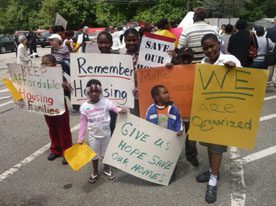
Homeownership Is Not Always Best
The first and most obvious lesson that should come out of this disaster is that it is not always best for people to be homeowners. This is true as a general proposition, but it is especially the case when the housing market is in a bubble, as it has been since the beginning of the decade.
Homeownership can often be a way for families to get good stable housing as well as an effective vehicle for them to accumulate wealth. However, this is not true everywhere and always. Specifically, owning a home is not likely to be a wise investment for families in unstable work or family situations.
There are large transaction costs associated with buying and selling a home. The round-trip cost on the purchase and sale of a house averages close to 10 percent of the purchase price. This would typically be the equivalent of about a year and a half worth of rent. If a family can only stay in a home for two to three years, these transaction costs can effectively boost their cost of housing by more than 50 percent, compared with what they would have paid to rent a comparable unit.
If a family does not expect to be able to stay in a home for at least five years, then they are likely to lose by being owners rather than renters. Those who do not have stable family or employment situations will typically be much better off renting than owning. It was irresponsible that many people in policy positions urged homeownership on families who did not expect to stay in their homes for a substantial period of time. It was especially irresponsible that they urged homeownership for these families in a context where house prices were clearly out of line with long-term trends. The bubble made it virtually certain that new homebuyers would lose money on their houses.
Having failed to recognize the bubble and warn against it, most people in the policy community are still not seriously addressing the fallout from this crisis. Specifically, we are facing a situation in which foreclosures are taking place at a rate of more than 150,000 a month, a pace that is likely to continue at least through 2010 and possibly well into 2011.
The most widely proposed response to this situation has been to urge lenders to arrange loan modifications, with some assistance from the federal government. While the modification programs have helped some homeowners, less than 15 percent of those facing foreclosure have even entered the loan modification process. Many of those who enter the process will not succeed in getting a modification. And many homeowners who do get a modification will subsequently default a second time, and thereby end up losing their home anyway. In such cases, the modification process will have only succeeded in delaying the loss of a home by six months or a year. On the current path, it is unlikely that more than 10 percent of the homeowners facing foreclosure will have successful modifications, meaning that 90 percent of the families in this situation will lose their homes.
Modification can also be costly to taxpayers. Many of the proposals involve the government giving servicers thousands of dollars per loan modified, plus guarantees that could lead to payments in the tens of thousands of dollars. Since some of these homeowners would have been able to stay in their home even without assistance, and some will end up losing their home even with assistance, these programs end up having a high cost for each foreclosure prevented. To a large extent, the banks, not the homeowners, are the main beneficiaries of these programs, as they collect far more on these mortgages than would otherwise be the case. This gap is especially clear in the cases where the homeowner ends up redefaulting. In that situation the sole beneficiary of the program is the lender.
The Right to Rent Alternative
There is a simple alternative that could instantly provide housing security to the vast majority of families facing foreclosure. Congress could vote to temporarily change the rules on foreclosure to allow homeowners to remain in their homes as renters for a substantial period of time (e.g., 5 to 10 years) following a foreclosure. During this time, homeowners would pay the market rent for their house. This change would instantly provide housing security to the millions of families who now fear losing their home, without any new bureaucracy and with no taxpayer dollars.
The basic point is very straightforward. The “right to rent” rule would be a temporary change to the foreclosure procedure in recognition of the extraordinary situation created by the collapse of the housing bubble and by the proliferation of bad mortgages that fed the bubble. It could be limited by both the years in which mortgages were issued (e.g., 2002–2007) and the value of the house. The latter limit could be set relative to the median house price in an area. For example, it could apply only to homes that sold for less than 120 percent of the median price in a metropolitan area. This information is readily available from Census Bureau data.
Under the right to rent rule, the judge or court officer handling the foreclosure would offer the homeowner the option to stay as a tenant following the foreclosure. If the homeowner is interested, then the judge would arrange to have an appraisal done to determine the rental value of the house. The appraisal would assign a rental value to the home based on the rent of comparable units in the area, just as an appraisal for sale assesses the sale price based on the sales price of comparable units in the area. The cost of the appraisal would be split between the homeowner and the lender.
For subsequent years, the rental price would be adjusted in step with the consumer price index for rent for the nearest metropolitan area. At any future point, if either party felt that the rent was out of line with the market, they could request a new appraisal from a judge. The party requesting the appraisal would pay the full cost of the appraisal, which should discourage frivolous requests.
The rules governing the rental unit would be the same as those that apply to other rentals in the area, with one major difference: the former homeowner would effectively be subject to a just cause eviction rule. It would not be possible for the lender to evict the former homeowner for the duration of time provided under the right to rent law without demonstrating cause.
How Right to Rent Helps Homeowners
In many of the former bubble markets a right to rent law would have allowed homeowners to remain in their homes at a much lower cost than what they had been paying as owners. During the housing bubble, house prices grew out of line with rents. This means that ownership costs based on bubble prices are far higher than current rents. This would be the case even if the homeowner were able to get a relatively low-cost mortgage.
For example, a recent paper by the Center for Economic and Policy Research, “The Gains from Right to Rent,” calculated that the monthly ownership costs would be $3,050 for someone who had, near the peak of the bubble, purchased a home in San Diego priced at 75 percent of the median for the area. By comparison, the rent on a comparable unit would be just $1,400, a savings of $1,650 a month. In Los Angeles, the ownership cost would be $3,300; rental cost of a comparable unit would be $1,350, a savings of $1,950 a month. There are similarly large savings for renting compared with ownership costs in most of the former bubble markets. There would even be savings in some of the markets that were not hugely inflated by the bubble. For example, in Minneapolis, the savings from renting would be about $450 a month. In Philadelphia the saving would be about $270 a month. As a result of these savings, many current homeowners who find their mortgage unaffordable would be able to easily pay the market rent on the home they now own.
While a secure rental unit is certainly better for current homeowners than simply being foreclosed upon and thrown out of their homes, an additional benefit of a right to rent policy is that it would make foreclosure less likely by making it a much less attractive option for lenders. With a right to rent rule, lenders would still have the option of reselling a foreclosed home to a third party, but the right to rent would remain attached to the property and bind the new owner. In other words, if a homeowner were guaranteed the right to stay in their home as a renter for five to 10 years following a foreclosure, the homeowner would still have this right even if the lender opted to sell the home.
Having a renter attached to a property will generally reduce its sales value. This would make foreclosing on homes less attractive to lenders. As a result, lenders would be more likely to pursue alternatives to foreclosure, such as modifications that allow homeowners to remain in their homes as owners. For this reason, the granting of right to rent not only gives homeowners facing foreclosure more security in their home, it also almost certainly increases the probability that they will be able to stay in their house as homeowners.
Objections to Right to Rent
There have been three main objections raised to right to rent:
- Banks have no experience being landlords.
- This change in foreclosure rules will hurt banks and therefore lead to higher mortgage interest rates in the future.
- It interferes with the sanctity of contract.
There are ready responses to each objection.
It is true that most banks have no experience as landlords, but the banks as landlords problem can be easily addressed. In most cases, banks would presumably contract out to management companies to deal with former homeowners turned tenants. This is done all the time. It is not that uncommon for banks to come into possession of rental properties and this is usually how they deal with the situation.
Banks also argue that changing the rules on foreclosure will lead to larger losses and therefore make future mortgage lending more risky, requiring higher mortgage interest rates. However, the whole point of this temporary change in foreclosure rules is that it is attributable to an extraordinary situation — the collapse of an $8 trillion housing bubble. There is no reason to depart from standard foreclosure rules in normal times, but these are not normal times.
If this implies that banks may respond by being more cautious about making loans when it seems that house prices are rising out of step with the fundamentals of the housing market, then this would be another desirable side effect of the policy. We should want banks to exercise more caution in making loans when house prices are being inflated by a bubble. This would help stem the growth of the bubble, which is exactly the outcome that we would want.
Finally, there is the more general concern that changing the rules on foreclosure interferes with the sanctity of contract, in effect denying basic rights of individuals and corporations in the market. While there are undoubtedly legal issues that can and will be raised by a right to rent law, it is worth noting that it is changing the terms of enforcement for a contract, not directly taking property. In this respect, there is the important precedent of the 2005 change in the bankruptcy law that made it far more difficult to have debt discharged in bankruptcy.
This law did not apply only to debts incurred subsequent to its passage; it was also applied retroactively. As a result, people who had incurred debt under one set of bankruptcy rules were suddenly subject to a different set of bankruptcy rules with regard to paying back their loans. At the time of the debate, this retroactive changing of the bankruptcy rules was never even raised as a serious issue. When it came to changing the rules to make them more generous to creditors, it seems that sanctity of contract was not an issue.
Prospects for Right to Rent
At this point, there is no current bill on right to rent before Congress, although Rep. Raúl Grijalva, from Tuscon, Ariz., did introduce a bill in the last session. Illinois Sen. Richard Durbin, the second ranking Democrat in the Senate, has indicated his support for the proposal and may introduce a bill in the current session. There has also been interest from many state legislators, although no state has yet passed a right to rent law.
Fannie Mae recently made a big step in granting a limited right to rent, with its “lease for deed” plan. Under this plan, foreclosed homeowners would be granted a one-year lease at the market rent, with a possibility for renewals. This doesn’t give quite the same security as a five- to 10-year binding commitment, but it is a huge step in the right direction. Freddie Mac has also allowed foreclosed homeowners to stay on as renters, but only on month-to-month leases.
The country is on a path where it is likely to see foreclosures at a pace of more than 150,000 a month for at least two years. Existing loan modification programs at best benefit a small fraction of the families facing foreclosure. By contrast, granting foreclosed homeowners the right to rent would immediately help the vast majority of those families while creating no new bureaucracy and without using any taxpayer dollars.





Comments